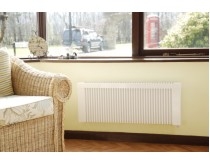Vertical or Horizontal Electric Radiators - What Are Best?

There are two main types of electric radiator - vertical radiators or horizontal radiators. By far the most common type of radiator is the horizontal one. If you are thinking about installing new radiators in your home, you are probably wondering what's best for your house.
In this article, we are going to look at the pros and cons of each type of radiator. Thankfully, they operate using the same electric boilers, so if you are replacing one type of radiator with the other it will notaffect your choice of boiler.
A Crucial Difference and Something You Didn't Know : Vertical and horizontal radiators are exactly what you would expect. Horizontal radiators have a bigger width than they do height and vertical ones have a bigger height than they do width. It's easy, right.
Something not many people know is that you do not always have to have the long rectangular radiator style. The truth is you can have your radiators custom-made to suit your home. Whatever the dimensions of the room, you can have a radiator crafted to suit that specific shape.
If you have precise needs, it might be worth looking into getting a custom-built radiator, as the standard sizes might not work for you. Take note: a custom radiator will cost significantly more than a standard ‘off the shelf' radiator.
Energy Usage : Both types of radiator come in electric and steam models. You will have to consider the type of energy you want to use before choosing between the two.
Steam radiators will use pipes to carry water from the boiler to the heating elements within the radiator. This creates steam, and therefore heat. Electric radiators use electrical wiring to create the same effect.
Vertical electric radiators do not require a boiler to function correctly. This can help to reduce the costs of installation, which is ideal if you are running to a strict budget.
Aesthetics : The real difference is in the aesthetics of each type of radiator. Many people prefer horizontal radiators because these can be hidden behind sofas and other objects. Vertical radiators are much more intrusive and cannot be hidden. You will have to have a specific idea in mind if you want to go with these ones.
Location Issues : Consider each type of radiator based on the layout of your room. A vertical radiator will work better in a smaller room where you do not have the wall space for a horizontal radiator. On the other hand, a hallway area might work best with a horizontal option.
This is where Electrical Heating Supplies (EHS) recommends calling in the help of a professional engineer to help deal with concerns relating to space. They will be able to give you an idea of how the installation will work, as well as being able to provide you with some recommendations.
Overall, there is little functional difference between the two types of radiator. Instead, they give you the flexibility needed to organise your home in the way you see fit. They allow you to have a comprehensive central heating solution in every room.
